| Into the
Valley...  RAF VALLEY - 60th
Anniversary Airshow 18 August RAF VALLEY - 60th
Anniversary Airshow 18 August
Andrew Bates went west to the far shores
of Anglesey.
After an absence of seven years, it was a pleasant
surprise to see RAF Valley once again listed in this year's UK airshow calendar.
Celebrating 60 years of operations in Anglesey, the show made a welcome return to this
region of North Wales, subsequently proving more popular than the organisers dared imagine
- more of which later (although this may be partially attributed to the very reasonable
admission prices - an adult ticket was only £7.50 in advance).
| RAF Valley - a
brief history Officially opened on 13
February 1941, RAF Rhosneigr, as it was initially known, was assigned to No.9 Group,
Fighter Command. However, just less than two months later, the station had been re-named
RAF Valley. For the next couple of years, a variety of fighter squadrons operated from the
airfield, some of which were assigned to night operations. First to reside at Valley were
the Hurricanes of 312 (Czech) Squadron. Other units included 219, 615, & 302 (Polish)
Squadrons, also equipped with the Hurricane, along with the Beaufighters of 68 Squadron
and the Defiants of 456 (RAAF) Squadron.
The airfield saw a complete change of task during 1943,
when it became a receiving and despatch centre for some of the vast numbers of USAAF
aircraft that would arrive on an almost daily basis from the States. With Valley ideally
situated on the West Coast of the UK, this would prove to be Valley's primary function for
the remainder of the war.
The immediate post-war years saw the airfield being used
temporarily by a handful of units, to the point where it was on a care and maintenance
basis, despite being designated as a Master Diversion Airfield. However, 1949 saw the
arrival of 20 Squadron, who managed a two year stint with a miscellany of types. This
included a short spell of Vampire operations, signifying Valley's first real taste of the
jet age.
It was in 1951 that the station became part of Flying
Training Command, which saw the commencement of RAF jet training from Valley, and has
subsequently proved to be their primary raison d'Ítre for the last 50 years. First unit
was 202 Advanced Flying School, which utilised the Vampire FB5 and T11, along with the
Meteor T7. This unit was destined to become 7 Flying Training School following a
reorganisation in 1954.
As a result of yet another organisational change, which
saw 7 FTS transfer to Linton-on-Ouse, 4 FTS was reformed at Valley in 1960, with the
Vampire T11 still dominating the flightline. However, two years later, deliveries of the
Gnat T1 began to replace the venerable Vampire, whilst the Gnat itself was supplemented by
the arrival of both single and two seat Hunters in 1967, the F6 and T7 variants
respectively. Finally, in 1976, the first Hawk T1 arrived at Valley, with subsequent
deliveries enabling complete replacement of the Gnats and Hunters by 1979.
Valley and 4 FTS were destined to take on an even more
significant role in the RAF fast jet training syllabus during the early nineties, when
tactical weapons training was added to their repertoire, following the disbandment of the
two Tactical Weapons Units. RAF Brawdy and 1 TWU were the first to go, followed a year or
so later by RAF Chivenor's 2 TWU. Consequently, the two reserve squadrons (19 & 208)
that constitute 4 FTS, can call upon a combined fleet of approximately 60 Hawks. With the
aircraft currently being progressed through the fuselage replacement programme, it's
highly likely that the Hawk will remain a common sight in the skies above Anglesey for
many more years to come. |
Quite naturally, examples of the Hawk dominated the
static during the show, with one of the two display areas almost entirely devoted to the
type, apart from a lone Chipmunk looking slightly out of place. Although the Hawks were a
little crowded together, at least some thought had gone into providing a variety of colour
schemes, including a pair of 208(R) Squadron machines sporting
their newly introduced squadron colours flanking the fuselage roundel, looking very smart
on a gloss black background. Also, it was unusual to see one of the 2001 display mounts
parked in the static rather than out on the flightline, along with another 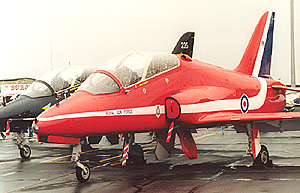 rarely seen static participant, a Red Arrow. This last mentioned
Hawk (XX156) is a relatively new recruit to the Reds fleet, having previously been based
at Valley with 4 FTS until early last year. rarely seen static participant, a Red Arrow. This last mentioned
Hawk (XX156) is a relatively new recruit to the Reds fleet, having previously been based
at Valley with 4 FTS until early last year.
Providing a subtle change from the familiar profile of an
RAF Hawk was the BAE Systems Hawk 102D ZJ100. From a personal point of view, although I've
seen this particular aircraft on a number of occasions, the almost ever-changing paint
schemes maintain the interest. Previous incarnations have seen a three-tone camouflage, air defence grey (yawn),
and a stunning blue scheme. Can hardly wait for the next
makeover!
The remaining static display, whilst well spaced, was
frankly a little disappointing. There were a couple of gems on display for the
enthusiasts. - an Irish Air Corps SA.365 Dauphin from No.3
Support Wing at Baldonnel was one highlight, along with one of the newly introduced
QinetiQ (ex-DERA) Alpha Jets. Seeing an Alpha Jet in GAF lizard
camouflage, complete with red and blue roundels and UK serial, certainly takes some
getting used to! However, apart from a Tornado F3 from 56(R) Squadron, there was a dearth
of RAF frontline hardware in the static, although the support helicopter role was well
represented by the Chinook, Puma, and Merlin.
International participation was also a little sparse.
Apart from the Irish contingent, (who also brought along an SF260
Warrior), the only other foreign representation came from Germany, with the Luftwaffe
sending a UH-ID, Tornado and Transall for the static display.
As the afternoon's flying display beckoned, the weather
decided to take a hand in proceedings. Admittedly, the forecast had predicted showers for
the afternoon, but when the first shower arrived, it pretty much stayed for the remainder
of the day. Whilst it was not particularly heavy, the persistence was enough to dampen the
spirits of the most hardy individual. Regrettably, your scribe followed his instincts;
'when the going gets tough, the tough hide in the display hangar'. Either I'm getting old
or memories of a soaking at Binbrook '87 still remain, or both! Consequently, the flying
was subsequently viewed from the hangar, along with many more like minded souls.
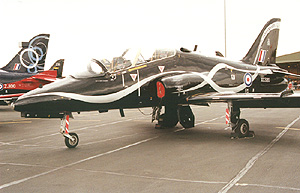 Despite the weather, the cloudbase was not too low, so the flying
programme continued regardless. The Tornado GR1 display was very impressive, with the
reheat glowing nicely against the grey clouds, whilst the Hunter/Gnat combination from
Kemble performed an especially welcome and fitting display to help celebrate 60 years of
RAF Valley. However, it was the home team who perhaps temporarily stole the limelight from
the Red Arrows. Using eighteen carefully positioned Hawks, 4 FTS managed to fly a
formation flypast in the shape of the number 60, despite the inclement weather. Despite the weather, the cloudbase was not too low, so the flying
programme continued regardless. The Tornado GR1 display was very impressive, with the
reheat glowing nicely against the grey clouds, whilst the Hunter/Gnat combination from
Kemble performed an especially welcome and fitting display to help celebrate 60 years of
RAF Valley. However, it was the home team who perhaps temporarily stole the limelight from
the Red Arrows. Using eighteen carefully positioned Hawks, 4 FTS managed to fly a
formation flypast in the shape of the number 60, despite the inclement weather.
As the rain continued to fall, annoyance and dismay
turned to stark realisation that perhaps an early exit was called for. After a slow trudge
back to the car, a last sandwich, and cameras safely stowed away, the engine was started
ready for the three-hour drive home. The time was 15:15, but this was just the beginning
of the nightmare to follow. Despite the poor weather, the cars had continued to  stream onto the airfield well into the afternoon. Consequently, many
of the earlier visitors had probably reached the same conclusion as myself that an early
departure was the best option. So, after moving approximately 100 yards, I came to a halt,
then waited, and waited……….. To cut a very long story short, I drove out of
the gate at RAF Valley at 19:05 - nearly four hours just to get off the airfield!
Regrettably, from the point of view of a regular airshow attendee over the past seventeen
years, this proved to be the worst airshow traffic I've ever encountered. This is no
exaggeration, and for many people in the queue, the frustration was soon readily apparent,
judging by the multitude of blaring car horns. Alas, all to no avail. stream onto the airfield well into the afternoon. Consequently, many
of the earlier visitors had probably reached the same conclusion as myself that an early
departure was the best option. So, after moving approximately 100 yards, I came to a halt,
then waited, and waited……….. To cut a very long story short, I drove out of
the gate at RAF Valley at 19:05 - nearly four hours just to get off the airfield!
Regrettably, from the point of view of a regular airshow attendee over the past seventeen
years, this proved to be the worst airshow traffic I've ever encountered. This is no
exaggeration, and for many people in the queue, the frustration was soon readily apparent,
judging by the multitude of blaring car horns. Alas, all to no avail.
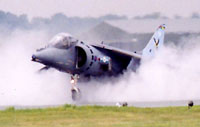 Whilst waiting patiently (well almost)
to go home, I tuned in to one of the local radio stations to help pass the time. Here,
they were broadcasting various tales of woe from listeners who had apparently queued for
up to five hours to get in to the show at Valley, only to be turned away at the gate
because the airfield was full. So, it seems I was actually one of the lucky ones!! It
later transpired that the organisers were anticipating a maximum of 35,000 people
attending, but on the day, over 50,000 people passed through the gates. So, although the
show would have been a great success in terms of money raised for charity, it was a real
shame that many people attending would have returned home with soured memories of what
would have normally been a great day out. Whilst waiting patiently (well almost)
to go home, I tuned in to one of the local radio stations to help pass the time. Here,
they were broadcasting various tales of woe from listeners who had apparently queued for
up to five hours to get in to the show at Valley, only to be turned away at the gate
because the airfield was full. So, it seems I was actually one of the lucky ones!! It
later transpired that the organisers were anticipating a maximum of 35,000 people
attending, but on the day, over 50,000 people passed through the gates. So, although the
show would have been a great success in terms of money raised for charity, it was a real
shame that many people attending would have returned home with soured memories of what
would have normally been a great day out.
It gives this reviewer no pleasure at all to criticise
any aspect of a show, as I am only too well aware of all the hard work and effort, not to
mention expense, that goes into organising an airshow in these budget conscious times.
However, the traffic management really did prove to be a major problem, and whilst any
future events planned at Valley would undoubtedly be welcomed in this airshow starved
region of the country, it is hoped that some serious thought be given to a workable
solution. Perhaps a park and ride scheme could be introduced. Whatever happens, hopefully
it won't be another seven year wait before the next show.
Damien Burke provides another
account of the show - it seems his experiences were very similar to Andrew's!
 Arriving early - as is sensible - entry to the
airfield was quick. It took quite a while to actually get parked as two lines of traffic
were filtered right to the other side of the airfield and parked up on the grass. A
ludicrous number of signs dotted the airfield - turn your mobile phones off, don't smoke,
don't stay with your car, don't expect the Eurofighter to turn up...(actually, I made that
last one up). Unfortunately for many others who didn't make an early start, the result was
up to three hours of queuing across Anglesey topped off with being told the airfield was
full - even for those with advance tickets. Oops... Arriving early - as is sensible - entry to the
airfield was quick. It took quite a while to actually get parked as two lines of traffic
were filtered right to the other side of the airfield and parked up on the grass. A
ludicrous number of signs dotted the airfield - turn your mobile phones off, don't smoke,
don't stay with your car, don't expect the Eurofighter to turn up...(actually, I made that
last one up). Unfortunately for many others who didn't make an early start, the result was
up to three hours of queuing across Anglesey topped off with being told the airfield was
full - even for those with advance tickets. Oops...
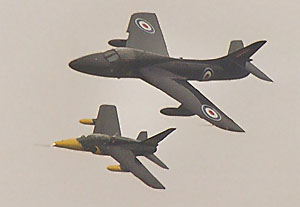 Setting up on the crowdline, the absence of any visible commentary
speakers was noted with approval. Until it was realised they weren't hidden, they just
weren't there! Only a tiny stretch had any speakers, so communication between organisers
and crowd was practically non-existent. The action kicked off with a mass Hawk take-off,
and they soon came back in fine style, spelling out '60' in the sky. 2001 was RAF Valley's
60th birthday, and coincidentally also the 80th birthday of No.4 Flying Training School -
and the 25th anniversary of the introduction of the Hawk to RAF service! Such a collection
of anniversaries was the major reason for there being a show at Valley, the bi-annual
shows having disappeared into history with the contractorisation of the station. With
civilian contractors running everything from ATC to airfield cleaning, the days of running
an airshow on the cheap using service personnel only are long-gone at Valley. Now a swathe
of civilians need to be paid - and paid weekend rates - for the airshow to go ahead. Setting up on the crowdline, the absence of any visible commentary
speakers was noted with approval. Until it was realised they weren't hidden, they just
weren't there! Only a tiny stretch had any speakers, so communication between organisers
and crowd was practically non-existent. The action kicked off with a mass Hawk take-off,
and they soon came back in fine style, spelling out '60' in the sky. 2001 was RAF Valley's
60th birthday, and coincidentally also the 80th birthday of No.4 Flying Training School -
and the 25th anniversary of the introduction of the Hawk to RAF service! Such a collection
of anniversaries was the major reason for there being a show at Valley, the bi-annual
shows having disappeared into history with the contractorisation of the station. With
civilian contractors running everything from ATC to airfield cleaning, the days of running
an airshow on the cheap using service personnel only are long-gone at Valley. Now a swathe
of civilians need to be paid - and paid weekend rates - for the airshow to go ahead.
With the 60 flypast had come the rain. A light misting at first, it soon ramped up until
it was steady drizzle. Despite the weather, Eddie Todd's brightly coloured Jet Provost
took to the skies. He put on a superb 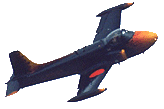 performance - I've
never seen a JP display anything like it. At times he seemed to be hovering, and surely
tested the boundaries of the JP's low-speed flight regime! Similarly precise control was
demonstrated in the very different display of the Kia Cars aerobatic stunt team - that Cub
pilot really wrings every bit of drama out of his landing-on-a-moving-trailer routine! performance - I've
never seen a JP display anything like it. At times he seemed to be hovering, and surely
tested the boundaries of the JP's low-speed flight regime! Similarly precise control was
demonstrated in the very different display of the Kia Cars aerobatic stunt team - that Cub
pilot really wrings every bit of drama out of his landing-on-a-moving-trailer routine!
 One
thing about wet airshows is that you can at least be assured of some good spray when the
Harrier is on, and we weren't disappointed. Taking off in a cloud of steam, and finishing
his display in another one, the 20(R) Squadron display ship was excellent as ever. By now
though the wet weather and cold were getting to the crowd, and plenty of people were
leaving - that is, those that weren't queuing for the toilets. And my, what a
queue...almost as long as the one on the road outside. Somebody miscalculated badly, and
toilet provision was adequate for a few thousand people at most, not the 50,000 that
turned up. One
thing about wet airshows is that you can at least be assured of some good spray when the
Harrier is on, and we weren't disappointed. Taking off in a cloud of steam, and finishing
his display in another one, the 20(R) Squadron display ship was excellent as ever. By now
though the wet weather and cold were getting to the crowd, and plenty of people were
leaving - that is, those that weren't queuing for the toilets. And my, what a
queue...almost as long as the one on the road outside. Somebody miscalculated badly, and
toilet provision was adequate for a few thousand people at most, not the 50,000 that
turned up.
Back to the flying though, and a quick round-up of the notable acts...the Reds were as
precise as always, but limited to their flat show by the low cloudbase. Warbird attendance
was impressive given the weather, with two Spitfires and a Mustang, a Beech 17, the
Blenheim and Lysander taking to the air. Sadly the far more modern Sea Vixen and Typhoon
both cancelled because of the weather. Nuff said!
On the jet warbird front, we were treated to a superb display from Peter Helier's Hunter
F6 (thankfully much closer to the crowd than at previous outings this year), Delta's Gnat
and Hunter pair, a Vampire (nice display but rather distant) and de Havilland's yellow
Venom, back in the air after its mishap at Biggin earlier in the year.
 For
the noisier side of things, the RAF provided the aforementioned Hawks, Reds and Harrier,
plus Jaguar, Tornado, Nimrod and a Hawk airfield attack.
Providing more explosions was the James Bond double act of BMW and L-39 - with a rather
wet Bond double driving around being buzzed by the L-39 while explosions were set off in
the background. Nicely done. For
the noisier side of things, the RAF provided the aforementioned Hawks, Reds and Harrier,
plus Jaguar, Tornado, Nimrod and a Hawk airfield attack.
Providing more explosions was the James Bond double act of BMW and L-39 - with a rather
wet Bond double driving around being buzzed by the L-39 while explosions were set off in
the background. Nicely done.
While a yellow Sea King took to the air, it didn't display, and it soon became apparent
that that was it - no more flying, just more and more rain. And then, the traffic
nightmare... I'd been keeping an eye on one Land Rover that had been trying to leave since
about 15:00, and by 17:00 it had only just moved out of sight. While I did a run round the
static on the off-chance there was anything worth taking a photo of given the poor light,
I spotted the same Landrover leaving the airfield - at 18:30! Anyway, not fancying a
multi-hour queuing session, when I got back to my car I used every trick in the book to
exit the airfield (perhaps I should buy up www.damiens-airshow-departure-tricks.com), and
a mere 45 minutes later was enjoying a nice meal in a pub about ten miles away. For most,
though, it was a nightmare crawl out of the airfield as the organisation once again failed
to live up to expectations.
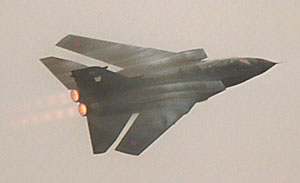 Overall,
this was a seriously disappointing show. Lesser mortals left early, such was their
disappointment, but having spent wads of cash on B&Bs and petrol, I was damned if I
was going to leave even one minute before the show finished! If Valley are going to bring
back the show as a regular one, they really need to get toilet provision and traffic
sorted out, because it was without a doubt the worst I've ever seen on these two counts.
Thankfully what flying there was (and there was more than at RIAT last year which had
better weather, so well done for that) was pretty good, particularly that first JP
display. Admission was also reasonable. So, nothing more to say - must try harder chaps! Overall,
this was a seriously disappointing show. Lesser mortals left early, such was their
disappointment, but having spent wads of cash on B&Bs and petrol, I was damned if I
was going to leave even one minute before the show finished! If Valley are going to bring
back the show as a regular one, they really need to get toilet provision and traffic
sorted out, because it was without a doubt the worst I've ever seen on these two counts.
Thankfully what flying there was (and there was more than at RIAT last year which had
better weather, so well done for that) was pretty good, particularly that first JP
display. Admission was also reasonable. So, nothing more to say - must try harder chaps!
|

 rarely seen static participant, a Red Arrow. This last mentioned
Hawk (XX156) is a relatively new recruit to the Reds fleet, having previously been based
at Valley with 4 FTS until early last year.
rarely seen static participant, a Red Arrow. This last mentioned
Hawk (XX156) is a relatively new recruit to the Reds fleet, having previously been based
at Valley with 4 FTS until early last year. Despite the weather, the cloudbase was not too low, so the flying
programme continued regardless. The Tornado GR1 display was very impressive, with the
reheat glowing nicely against the grey clouds, whilst the Hunter/Gnat combination from
Kemble performed an especially welcome and fitting display to help celebrate 60 years of
RAF Valley. However, it was the home team who perhaps temporarily stole the limelight from
the Red Arrows. Using eighteen carefully positioned Hawks, 4 FTS managed to fly a
formation flypast in the shape of the number 60, despite the inclement weather.
Despite the weather, the cloudbase was not too low, so the flying
programme continued regardless. The Tornado GR1 display was very impressive, with the
reheat glowing nicely against the grey clouds, whilst the Hunter/Gnat combination from
Kemble performed an especially welcome and fitting display to help celebrate 60 years of
RAF Valley. However, it was the home team who perhaps temporarily stole the limelight from
the Red Arrows. Using eighteen carefully positioned Hawks, 4 FTS managed to fly a
formation flypast in the shape of the number 60, despite the inclement weather. stream onto the airfield well into the afternoon. Consequently, many
of the earlier visitors had probably reached the same conclusion as myself that an early
departure was the best option. So, after moving approximately 100 yards, I came to a halt,
then waited, and waited……….. To cut a very long story short, I drove out of
the gate at RAF Valley at 19:05 - nearly four hours just to get off the airfield!
Regrettably, from the point of view of a regular airshow attendee over the past seventeen
years, this proved to be the worst airshow traffic I've ever encountered. This is no
exaggeration, and for many people in the queue, the frustration was soon readily apparent,
judging by the multitude of blaring car horns. Alas, all to no avail.
stream onto the airfield well into the afternoon. Consequently, many
of the earlier visitors had probably reached the same conclusion as myself that an early
departure was the best option. So, after moving approximately 100 yards, I came to a halt,
then waited, and waited……….. To cut a very long story short, I drove out of
the gate at RAF Valley at 19:05 - nearly four hours just to get off the airfield!
Regrettably, from the point of view of a regular airshow attendee over the past seventeen
years, this proved to be the worst airshow traffic I've ever encountered. This is no
exaggeration, and for many people in the queue, the frustration was soon readily apparent,
judging by the multitude of blaring car horns. Alas, all to no avail. Whilst waiting patiently (well almost)
to go home, I tuned in to one of the local radio stations to help pass the time. Here,
they were broadcasting various tales of woe from listeners who had apparently queued for
up to five hours to get in to the show at Valley, only to be turned away at the gate
because the airfield was full. So, it seems I was actually one of the lucky ones!! It
later transpired that the organisers were anticipating a maximum of 35,000 people
attending, but on the day, over 50,000 people passed through the gates. So, although the
show would have been a great success in terms of money raised for charity, it was a real
shame that many people attending would have returned home with soured memories of what
would have normally been a great day out.
Whilst waiting patiently (well almost)
to go home, I tuned in to one of the local radio stations to help pass the time. Here,
they were broadcasting various tales of woe from listeners who had apparently queued for
up to five hours to get in to the show at Valley, only to be turned away at the gate
because the airfield was full. So, it seems I was actually one of the lucky ones!! It
later transpired that the organisers were anticipating a maximum of 35,000 people
attending, but on the day, over 50,000 people passed through the gates. So, although the
show would have been a great success in terms of money raised for charity, it was a real
shame that many people attending would have returned home with soured memories of what
would have normally been a great day out. Arriving early - as is sensible - entry to the
airfield was quick. It took quite a while to actually get parked as two lines of traffic
were filtered right to the other side of the airfield and parked up on the grass. A
ludicrous number of signs dotted the airfield - turn your mobile phones off, don't smoke,
don't stay with your car, don't expect the Eurofighter to turn up...(actually, I made that
last one up). Unfortunately for many others who didn't make an early start, the result was
up to three hours of queuing across Anglesey topped off with being told the airfield was
full - even for those with advance tickets. Oops...
Arriving early - as is sensible - entry to the
airfield was quick. It took quite a while to actually get parked as two lines of traffic
were filtered right to the other side of the airfield and parked up on the grass. A
ludicrous number of signs dotted the airfield - turn your mobile phones off, don't smoke,
don't stay with your car, don't expect the Eurofighter to turn up...(actually, I made that
last one up). Unfortunately for many others who didn't make an early start, the result was
up to three hours of queuing across Anglesey topped off with being told the airfield was
full - even for those with advance tickets. Oops... Setting up on the crowdline, the absence of any visible commentary
speakers was noted with approval. Until it was realised they weren't hidden, they just
weren't there! Only a tiny stretch had any speakers, so communication between organisers
and crowd was practically non-existent. The action kicked off with a mass Hawk take-off,
and they soon came back in fine style, spelling out '60' in the sky. 2001 was RAF Valley's
60th birthday, and coincidentally also the 80th birthday of No.4 Flying Training School -
and the 25th anniversary of the introduction of the Hawk to RAF service! Such a collection
of anniversaries was the major reason for there being a show at Valley, the bi-annual
shows having disappeared into history with the contractorisation of the station. With
civilian contractors running everything from ATC to airfield cleaning, the days of running
an airshow on the cheap using service personnel only are long-gone at Valley. Now a swathe
of civilians need to be paid - and paid weekend rates - for the airshow to go ahead.
Setting up on the crowdline, the absence of any visible commentary
speakers was noted with approval. Until it was realised they weren't hidden, they just
weren't there! Only a tiny stretch had any speakers, so communication between organisers
and crowd was practically non-existent. The action kicked off with a mass Hawk take-off,
and they soon came back in fine style, spelling out '60' in the sky. 2001 was RAF Valley's
60th birthday, and coincidentally also the 80th birthday of No.4 Flying Training School -
and the 25th anniversary of the introduction of the Hawk to RAF service! Such a collection
of anniversaries was the major reason for there being a show at Valley, the bi-annual
shows having disappeared into history with the contractorisation of the station. With
civilian contractors running everything from ATC to airfield cleaning, the days of running
an airshow on the cheap using service personnel only are long-gone at Valley. Now a swathe
of civilians need to be paid - and paid weekend rates - for the airshow to go ahead. performance - I've
never seen a JP display anything like it. At times he seemed to be hovering, and surely
tested the boundaries of the JP's low-speed flight regime! Similarly precise control was
demonstrated in the very different display of the Kia Cars aerobatic stunt team - that Cub
pilot really wrings every bit of drama out of his landing-on-a-moving-trailer routine!
performance - I've
never seen a JP display anything like it. At times he seemed to be hovering, and surely
tested the boundaries of the JP's low-speed flight regime! Similarly precise control was
demonstrated in the very different display of the Kia Cars aerobatic stunt team - that Cub
pilot really wrings every bit of drama out of his landing-on-a-moving-trailer routine! One
thing about wet airshows is that you can at least be assured of some good spray when the
Harrier is on, and we weren't disappointed. Taking off in a cloud of steam, and finishing
his display in another one, the 20(R) Squadron display ship was excellent as ever. By now
though the wet weather and cold were getting to the crowd, and plenty of people were
leaving - that is, those that weren't queuing for the toilets. And my, what a
queue...almost as long as the one on the road outside. Somebody miscalculated badly, and
toilet provision was adequate for a few thousand people at most, not the 50,000 that
turned up.
One
thing about wet airshows is that you can at least be assured of some good spray when the
Harrier is on, and we weren't disappointed. Taking off in a cloud of steam, and finishing
his display in another one, the 20(R) Squadron display ship was excellent as ever. By now
though the wet weather and cold were getting to the crowd, and plenty of people were
leaving - that is, those that weren't queuing for the toilets. And my, what a
queue...almost as long as the one on the road outside. Somebody miscalculated badly, and
toilet provision was adequate for a few thousand people at most, not the 50,000 that
turned up. For
the noisier side of things, the RAF provided the aforementioned Hawks, Reds and Harrier,
plus Jaguar,
For
the noisier side of things, the RAF provided the aforementioned Hawks, Reds and Harrier,
plus Jaguar,  Overall,
this was a seriously disappointing show. Lesser mortals left early, such was their
disappointment, but having spent wads of cash on B&Bs and petrol, I was damned if I
was going to leave even one minute before the show finished! If Valley are going to bring
back the show as a regular one, they really need to get toilet provision and traffic
sorted out, because it was without a doubt the worst I've ever seen on these two counts.
Thankfully what flying there was (and there was more than at RIAT last year which had
better weather, so well done for that) was pretty good, particularly that first JP
display. Admission was also reasonable. So, nothing more to say - must try harder chaps!
Overall,
this was a seriously disappointing show. Lesser mortals left early, such was their
disappointment, but having spent wads of cash on B&Bs and petrol, I was damned if I
was going to leave even one minute before the show finished! If Valley are going to bring
back the show as a regular one, they really need to get toilet provision and traffic
sorted out, because it was without a doubt the worst I've ever seen on these two counts.
Thankfully what flying there was (and there was more than at RIAT last year which had
better weather, so well done for that) was pretty good, particularly that first JP
display. Admission was also reasonable. So, nothing more to say - must try harder chaps!